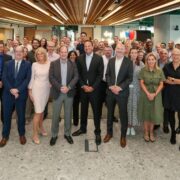Podcast Ep 123: Stephen McNulty explains how Ambisense uses real-time data to help firms manage their environment, reduce their carbon footprint and predict potential risks.
“It’s one of those seven-to-eight-year overnight success stories, right?” deadpans Ambisense CEO and co-founder Stephen McNulty as he recalls how as an engineer working for an environmental testing lab as a commercial director he realised that the dots weren’t being joined up when it came to harnessing data to more proactively manage environmental impact or risk.
“I was never an insider in that industry. I was an engineer among scientists. I knew what they could do, I knew what people wanted and I just didn’t think anyone was getting what they actually needed. So I was your stereotypical founder in that I was a pain in the backside as an employee.”
“Through better sensor technology, analytical tools and the internet of things, it is now possible to get data from the field and do something with that information”
He decided to do something with his frustration and pursued an MBA. During this time he befriended a research team in DCU and Ambisense was formed in 2013.
“Back then our first product was a sensor on a modem and a processor in a box, which all seems quaint now, but was revolutionary at the time. We saw a gap in the market for products led by data that would transform the environmental risk management market.”
McNulty’s hunch has paid off and today businesses of all sizes are working to reduce their carbon footprint by proactively managing their environment. The lynchpin of this is real-time data and analysis.
Analyse this
In recent weeks Ambisense revealed a new series of analytical tools called BEPA (Built Environment Performance Analytics) that help businesses to better understand the complex and nuanced correlations within built environments and provide data in which this can be improved upon. Built environments include office spaces, schools, hospitals and other varities of buildings in which people occupy space.
BEPA addresses challenges such as sustainability, air quality, working environment optimisation and building fabric performance. The first tools in the suite deal with air and thermal requirements – buildings need clean air that needs to be heated and cooled efficiently.
Another facet of Ambisense’s technology is construction and it emerged recently that the Irish company’s technology played an instrumental role in mitigating environmental risks and ensuring sustainability in the Lower Thames Crossing project.
Ambisense was involved in the preliminary ground surveys in support of Highways England’s Lower Thames Crossing, which is a once in a generation road upgrade that looks to transform links between Kent, Thurrock, and Essex in the UK. The scheme will positively impact the entire South-East of the UK and beyond, providing a key gateway for trade between the midlands and the north. This is the first major UK infrastructure project to use its procurement to target low carbon construction with incentives that drive further continuous carbon reduction across projects of this type.
Asked if Ambisense is a circular economy business or a tech business, McNulty says the business is all about technology. “We build products for the environmental risk management market. This market has traditionally been a very consulting-led business because of its complexity. Measuring things in the environment, whether it’s air pollution or water pollutants has historically been a very difficult thing to do in the field. You’ve got to take data and bring it to the lab. Often consultants have had to walk into the breach, but had little data and could offer expertise. Our mission is to augment that with technology. Through better sensor technology, analytical tools and the internet of things, it is now possible to get data from the field and do something with that information.
“So we’re building a product business that will find a home in different parts of the macro environmental risk management industry.”
Getting to the heart of the matter
McNulty says that by taking data from multiple sources and analysing that data, managers can understand the depth of a problem better. “Since Covid-19, for example, ventilation of buidlnigs has become more important than ever. With people returning to buildings the quality of the air we breathe is a factor in many parts of the industry where it wasn’t before.
“After Covid, the idea of pumping recirculated air through a building just isn’t possible because of virus particles. Companies now have dual objectives; they want to get to Net Zero but they need to make sure that the air they are circulating is safe.
“Ambisense has developed a granular way to assess air quality in meeting rooms for example. By pulling together data on occupancy rates, outside air quality and more we can come up with an optimal way to deliver good ventilation, bring in more fresh air and ensure firms can manage the carbon output of their building and reduce energy consumption.”
By using sensors and real-time data, McNulty believes building owners can predict issues before they arise.
“We’re moving the needle from reacting to environmental pollution, to predicting it in real-time and preventing it.”
With environmental and social governance (ESG) now in vogue in the business world, the Dublin business could be in the right place and the right time with the right tech.
“This decade demands significant change in how we operate; that means moving from reacting to pollution events to being able to prevent them from happening. And that’s where our products will be particularly good when you can put that data to work.”





